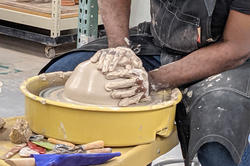Faculty members Deborah Zlotsky and Yevgeniya Baras and alumna Jennifer Garza-Cuen MFA 12 PH win 2019 Guggenheim Fellowships.
Structure, Balance and Support

In a year when good news is hard to find, Associate Professor Katy Schimert—who is also head of Ceramics—is thrilled to have earned a 2020 Guggenheim Fellowship and a Joan Mitchell Foundation Artist in Residence Award, both of which will provide creative latitude to intensify her studio practice. Her work is included in the current Making Knowing: Craft in Art, 1950–2019 exhibition at the Whitney (though the museum is currently closed because of COVID) and in 2019 was featured in a series of exhibitions celebrating the 50th anniversary of the moon landing.
Below, the Brooklyn-based artist discusses her ongoing Niagara Falls series and finding a balance between teaching and making.

How does it feel to win a Guggenheim?
I’ve applied for it a million times since the early 1990s, so it’s good to finally get it. I also won a Joan Mitchell Foundation grant for a six-week residency in New Orleans this fall, but that may be on hold due to the COVID-19 crisis.
“Teaching and making feed each other and work against each other, too. You have to get the balance right.”
Do you find it difficult to make work and teach at the same time?
Sometimes. Teaching and making feed each other and work against each other, too. So you have to get the balance right.
Like last fall I taught the professional practice class [in Ceramics] and worked with students writing their artist statements, so that really helped me with writing my Guggenheim application this round.
And having dialogues with colleagues has been so important to my practice. I learn so much from them—and from students, too.

“[Working with clay] reminds me of how the world was formed.”
You work in a variety of mediums, but do you mostly think of yourself as a ceramicist?
I would describe myself as a sculptor who uses ceramics, although I’ve used other materials too. I have always loved working with clay. The process reminds me of how the world was formed. It’s flexible until you put it in the kiln and fix that moment in time.
How does drawing and filmmaking fit in with your overall approach?
All of my work comes out of the language of post-minimalist sculpture and conceptual art. I work seamlessly between two and three dimensions, usually going back and forth between drawings and sculptures.

What subject matter inspires you most?
For a long time, I worked with iconic natural imagery that seems unfathomable—like the moon and the sun—and with intangible ideas like love and war and money.
“I got obsessed with the structural nature of [Niagara Falls] and started playing with that idea.”
And in recent years you’ve been working on a series inspired by Niagara Falls?
I grew up outside of Buffalo [NY]. When I was a kid, we’d all pile in the car and go to Niagara Falls. In the winter, it’s really extraordinary. But as an artist, my attempts to represent it kept coming back looking like other people’s art.
One time I went and I saw it so clearly—the structure of the falls. I realized the Canadian falls is concave and the American falls convex. So I got obsessed with the structural nature of the falls and started playing with that idea.

Do you consider your sculptures to be abstract?
I believe that a work of sculpture has to in some way acknowledge gravity and the world it lives in. Otherwise the viewer doesn’t really connect to it physically.
My falls sculptures have fronts and backs. I work long hours building up and carving the fronts, but the backs are kept raw, and in some ways I like them better. They’re more emotional. The fronts are more like clothing that you put on to show the world.


So are the pieces you’re working on now moving in a more figurative direction?
In a sense. The carved fronts of some of the more recent pieces started to have bodily implications. They make me think about medieval sculptures where the body and the draped robe the figure is wearing become one. It’s almost like a fossil with the drapery and the ribs coming together.
And the falls itself is like a heart in nature with all the pressure and rushing water, the rivers like blood.
“A work of sculpture has to in some way acknowledge gravity and the world that it lives in.”
How might those ideas play out in the studio?
I think I’ll use reds for these new pieces rather than the rich browns and pewters I’ve been focusing on. There are many beautiful reds you can make in ceramics.

With the added challenge of needing to teach remotely, are you finding any time to work in your studio this spring?
I have been working at home on my drawings since I’m unable to go to my studio [in Brooklyn]. But I’m really looking forward to getting back to it. There’s nothing like spending the whole day alone in the studio.
As an artist, I need periods of time—a year or two—where that’s what I do. So that’s why these grants and fellowships are so important. I’m sure it’s true for writers, scientists and historians, too—any kind of work where deep concentration is needed.
“As an artist, I need periods of time... [for] deep concentration.”
And if you don’t have that studio experience, there are certain things you would never be able to teach. A lot of art teaching is about problem solving, but fine art is more about self-expression—about finding your voice, which is what we’re all trying to do.
—interview by Simone Solondz / artwork photos by Sarah Trigg / studio photo by Jo Sittenfeld MFA 08 PH
April 21, 2020
![Photo of girl holding snake by Jennifer Garza-Cuen MFA 12 PH from her series Imag[in]ing America](/sites/g/files/upbtqy111/files/styles/landscape_3_2_250x166/public/2021-02/1557108327330_GarzaGirlwithSnake-listing.jpg?h=8af371aa&itok=li-vVoJP)

